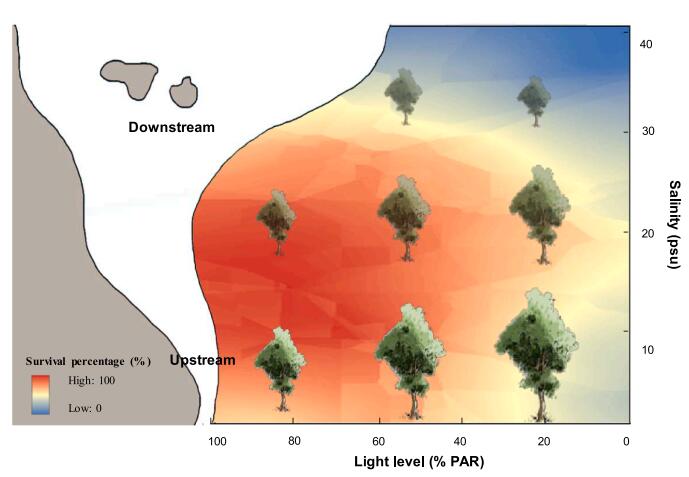Gu X.X., Feng H.Y., Tang T., Tam N.F.Y., Pan H., Zhu Q.C., Dong Y., Fazlioglu F. and Chen L.Z.. 2019. Ecological Engineering, 139: 105591.
Mangroves are critical inter-tidal ecosystems with high productivity and ecological signifcance. Afforestation was regarded as one of the key projects worldwide in recovering mangrove ecosystem function. Laguncularia racemosa, a non-native mangroves species in China has been used in mangrove afforestation, while its invasiveness is widely concerned. Understanding how it tolerates shade and salinity stresses is crucial as these factors can affect its invasive potential. However, the effects of soil salinity and light on mangroves (especially on nonnative species) are ambiguous. We examined the combined effects of salinity and light on the growth and physiological responses of L. racemosa and predicted an extensive range of dispersal habitats for L. racemosa in a typical estuary using Kriging model. The field surveys showed that the seedling density and seedling height were positively correlated with light availability but negatively correlated with salinity. Our greenhouse experiment also demonstrated that moderate shading (60–80% PAR) and low salinity treatments (0–10 psu) enhanced the survival and growth of seedlings, whereas high salinity limited their assimilation rates (A), independent of the light levels. Under high salinity (30 psu) and low light level (20%), L. racemosa seedlings employed a watersaving strategy (248.96 ± 24.27 µmol·mmol−1 in instantaneous water use efficiency), which helped them to improve their adaptability to stressful environmental conditions and maintain their growth. Our findings indicate the combined effects of salinity and light on the growth strategies of L. racemosa as well as its environmental tolerance to high salinity which limits its growth and survival in coastal ecosystems. These results can provide a reference for the management of non-native mangrove species in China and worldwide.

Figure 1. Survival percentages of Laguncularia racemosa seedlings grown under five light levels (100%, 80%, 60%, 40%, and 20% PAR) and five salinity treatments (0, 10, 20, 30, and 40 psu) during the 90-day greenhouse experiment.

Figure 2. Kriging method was used to predict the dispersal habitat of L. racemosa seedlings in the estuary area using the greenhouse data on survival rates for L. racemosa seedlings grown under different light and salinity treatments. The size of the tree indicates the height of the mature tree and the tree transparency indicates the possibility of survival. The red and blue zones indicate the highest and lowest percentages for seedling survival, respectively. (For interpretation of the references to colour in this fgure legend, the reader is referred to the web version of this article.)

